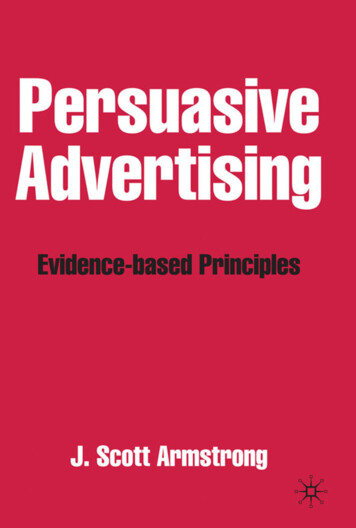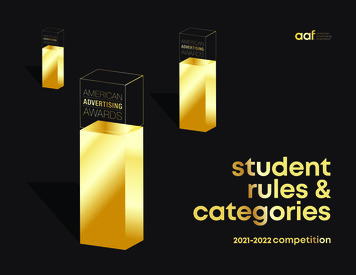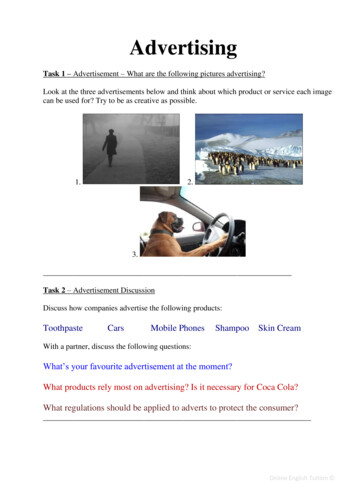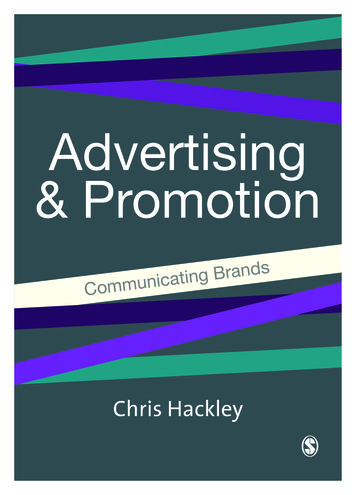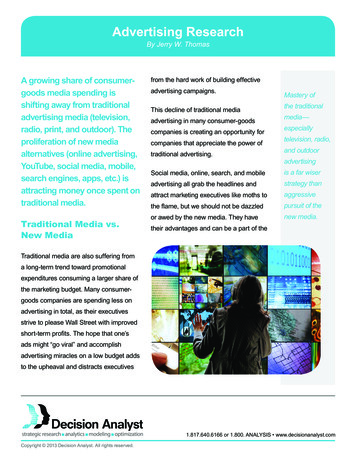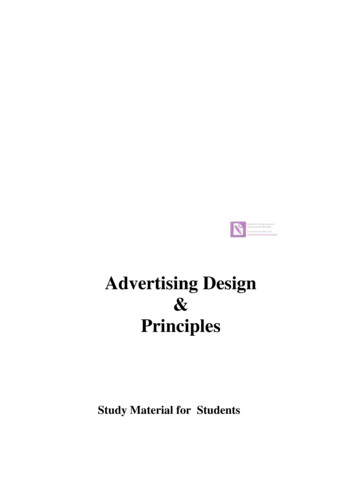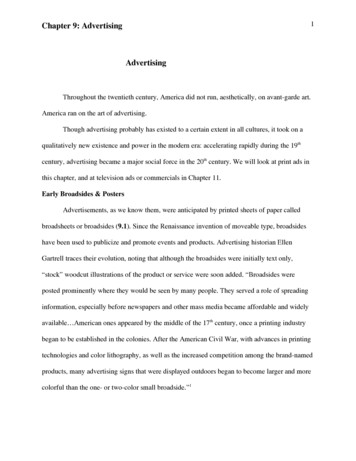
Transcription
1Chapter 9: AdvertisingAdvertisingThroughout the twentieth century, America did not run, aesthetically, on avant-garde art.America ran on the art of advertising.Though advertising probably has existed to a certain extent in all cultures, it took on aqualitatively new existence and power in the modern era: accelerating rapidly during the 19thcentury, advertising became a major social force in the 20th century. We will look at print ads inthis chapter, and at television ads or commercials in Chapter 11.Early Broadsides & PostersAdvertisements, as we know them, were anticipated by printed sheets of paper calledbroadsheets or broadsides (9.1). Since the Renaissance invention of moveable type, broadsideshave been used to publicize and promote events and products. Advertising historian EllenGartrell traces their evolution, noting that although the broadsides were initially text only,“stock” woodcut illustrations of the product or service were soon added. “Broadsides wereposted prominently where they would be seen by many people. They served a role of spreadinginformation, especially before newspapers and other mass media became affordable and widelyavailable American ones appeared by the middle of the 17th century, once a printing industrybegan to be established in the colonies. After the American Civil War, with advances in printingtechnologies and color lithography, as well as the increased competition among the brand-namedproducts, many advertising signs that were displayed outdoors began to become larger and morecolorful than the one- or two-color small broadside.”1
2Chapter 9: AdvertisingLarger, more colorful posters andbillboards began to supplant broadsides inthe nineteenth century. The development ofcolor lithography in 1870 allowed formore—and more captivating—images to bepasted on every available surface. Woodenbillboards (“boards for posting bills”) wereerected along railroad lines, bringingadvertising messages to train passengers.Circuses and theaters used postersextensively, their entertainment images9.1 A Broadside.becoming the ancestors of later film posters.French artist Henri de Toulouse Lautrec (1864-1901) created some of the most visuallyarresting posters of the late nineteenth century. Physically handicapped by a congenital disease,Lautrec was ostracized from the aristocratic realm of his forebears. He exiled himself to theParisian demimonde, spending his evenings with the prostitutes and entertainers of working classbars like the Moulin Rouge. Lautrec’s lithographic posters for the Moulin Rouge, especiallythose featuring the can-can dancer known as La Goulue (“the greedy one”), employed the sameangular compositions explored by his avant-garde contemporaries in the Impressionist and PostImpressionist movements (9.2). The curving contours of Lautrec’s figures, echoed in the sinuousletters of his poster texts, reflect the Art Nouveau style that dominated European graphic arts atthe end of the nineteenth century.
Chapter 9: Advertising9.2 Henri Toulouse-Lautrec, Jane Avril.3
Chapter 9: Advertising4Published AdvertisementsThe first American newspaper ad, which solicited a buyer for a Long Island Estate, waspublished in 1704, in the Boston News-Letter. By 1729, Benjamin Franklin’s PennsylvaniaGazette newspaper included several pages of “new advertisements.” A few years later, Franklin’sGeneral Magazine printed the first US magazine ads.The early power of ads was demonstrated in Phineas T. Barnum’s efforts to promote hisentertainments. In 1850, he brought Jenny Lind, the “Swedish Nightingale,” from Europe for atour of the US. He used newspaper ads, handbills, and broadsides to drum up interest in thesinger, who went from relative obscurity to national fame. Her ship was met on arrival by 30,000New Yorkers, all attracted by Barnum’s advertising campaign.The first US advertising agency was opened in Philadelphia in 1841. The industry grewso rapidly that by 1861, there were twenty ad agencies in New York City. The growingcommitment to advertising can be gauged by the fact that throughout the 1870s, a million dollarsannually was spent for ads for Lydia Pinkham’s Pink Pills (9.3).9.3 Lydia Pinkham, logo, packaging, and advertisement.
Chapter 9: Advertising5The first book on advertising published in America was George P. Rowell’s The MenWho Advertise: An Account of Successful Advertisers, Together with Hints on the Methods ofAdvertising. A handful of other manuals were published later in the 1870s; even more how-to’scame out in the 1880s.Early Advertising ImagesThe early development of pictorial ads can be traced in the pages of Harper’s Weekly. Anancestor of Time and Newsweek, it was a popular illustrated publication throughout the secondhalf of the nineteenth century. It carried the story of the impeachment of President AndrewJohnson, was instrumental in the 1871 campaign to defeat Boss William M. Tweed in New YorkCity, and the Civil War was documented—and illustrated--on its pages.Harper’s Weekly ads were initially text only. One example is a sewing machine ad from1858, which is comprised of the lyrics of a catchy song. In the mid-nineteenth century, peopleused to read ads; the fact that we now say see an ad indicates that ads have becomepredominantly visual.Advertising’s informative texts were augmented with black and white woodcutillustrations in the 1860s and 1870s. The invention of the linotype machine in 1874 advanced thepossibilities of color printing.Some early ads simply reproduced product labels, as the 1868 Harper’s Weekly ad forColgate & Co. Toilet Soaps. Other ads included illustrations generated solely for the advertisingcampaign.Humor was deployed in early ads, and with it ethnic stereotypes and the articulation ofclass differences (9.4). Both were shown visually and reinforced textually. An 1865 Harper’s
Chapter 9: Advertising6Weekly ad for Taylor & Young Pioneer Yeast Powder depicts an elegantly dressed upper-classwoman in the kitchen with her plump, plain Irish cook. The text of the ad reads:MISTRESS. “Why, Bridget, what are you doing—nailing those biscuits down to thetray?”COOK. “Yes, faith, Mum, or they’d be afther liftin’ the tops off you oven, Mum—thisYaste Powdher’s so moity powerful.”The class differences of the two women are visually coded, with the mistress portrayed asmuch younger and more attractive than her maid. Their ethnic differences are inscribed in theiruse of language, particularly the Irish woman’s poor grammar and pronunciation.9.4 1865 Harper’s Weekly ad for Taylor & Young Pioneer Yeast Powder.
Chapter 9: Advertising7Calvin Coolidge: Advertising & the Civilization of DesireThe modern role of advertising stemmed from the nineteenth-century divisions thatcaused Western culture’s social and artistic crisis of realism. Karl Marx had predicted in thenineteenth century that workers in capitalist countries would eventually revolt because ofcontinuing conditions of poverty and exploitation. Two steps significantly cut off such arevolution in twentieth-century America. One was the decision by industrialists--pioneered byHenry Ford--to raise wages to the point that the worker could become a consumer. (Marx hadpredicted a cycle of increasingly lower wages.) The second was the magnification of advertisingto the point that it could motivate workers to increased productivity--and to increasedconsumption.The possibilities of consuming as a way of life were spread by the increasingly pictorialads in photo-based newspapers and magazines.By 1926, advertising had reached sufficient importance to merit a major address by USpresident Calvin Coolidge (1872-1933). According to Coolidge, the basic function of advertisingwas education.“As we turn through the pages of the press and the periodicals, as we catch the flash ofbillboards along the railroads and the highways, all of which have become enormous vehicles ofthe advertising art, I doubt if we realize at all the impressive part that these displays are comingmore and more to play in modern life.“We see that basically it is that of education.It makes new thoughts, new desires, newactions.Rightfully applied, it is the method by which desire is created for better things.”Desire, in turn, is the crucial element separating the civilized from the uncivilized:
8Chapter 9: Advertising“The uncivilized make little progress because they have few desires. The inhabitants ofour country are stimulated to new wants in all directions. In order to satisfy their constantlyincreasing desires, they necessarily expand their productive powers. They create more wealthbecause it is only by that method that they can satisfy their wants. It is this constantly enlargingcircle that represents the increasing circle of civilization.”2President Coolidge saw the importance of advertising images in the modern economy, inwhich need must keep up with industrial output--even if need itself has to be artificiallystimulated by the new industry of advertising. Advertising images became icons that began toopen up a new dimension of the myth of the autonomous individual, an economic dimension thatincreasingly identified freedom to choose and the satisfaction of desires with consumption. Thelinking of desire with products has led some theorists to call our culture “The Culture of Desire.”Desire is clearly the subject of the 1928soap ad “Heart’s Desire” (9.5). The ad wasaimed at the people who were the underlyingsubject of President Coolidge’s speech--thelargely immigrant working class, who were thepotential equivalent, in America, of Europe’snineteenth-century proletariat. The imagecontains all the elements of Coolidge’s speech:the circle of civilization, desire, productivity,and progress. It also shows the trodden-downbodies of those who do not quite make the gradein such a competitive system. The civilization ofdesire can also become a civilization of greed.
Chapter 9: Advertising9Advertising: Icons against MarxismJust as President Coolidge’s description of advertising implied its central and politicalrole, American corporations were aware of its power to undercut the appeal of Marxism,especially during the labor unrest of the period. This dimension of America advertising is theliteral content of an early Chevrolet advertisement:“Every owner is in effect a railroad president.“The once poor laborer and mechanic now drives to the building operation orconstruction job in his own car. He is now a capitalist.His wages have been increased from 1.50 or 3.00 a day to 5.00 or 15.00 a day.“He has become somebody!.How can Bolshevism flourish in a motorized country.?”3Bolshevism could not, as American political and business leaders both knew. Karl Marxhad no idea of the power of advertising.The importance of advertising art was not in its artistic merit but in its radically newculture-building effect. Rather than present visual or ideological challenges—as avant-gardeartists tried to do—advertiser sought to link their products with what consumers already desired.Because they were so effective in doing so, advertising images, regardless of their artistic merit,emerged as the decisively new icons of the modern era.We will first explore how ads make ostensibly neutral products so desirable, that is, thestrategies used by advertisers to convince us to buy. Then we will analyze the images and ideasin many late-twentieth century print ads.Strategies of PersuasionMarket research began as early as 1891 when Nathan Fowler analyzed consumer patternsand recommended in Advertising Age that because women make most of the purchasing
10Chapter 9: Advertisingdecisions of their household, manufacturers would do well to direct their advertising messages tothem. Since then, ads were increasingly targeted to specific audiences.Advertisers have deployed a range of strategies to reach these audiences. Increasingly,they have emphasized experience over information. Rather than present us with specific detailabout their products—specifics we might think about and compare with the specifics of otherproducts—most ads present us with emotional appeals, seducing us with images of desirablepeople, places and experiences. Advertisers deploy various strategies to do so. They seek to givepower and personality to technological products and to corporations. They also use role modelsand celebrity endorsements; images of glamour and sex appeal; all kinds of humor; appeals toour longings for stronger bonds of family, friendship and community; as well as promises ofleisure, self-improvement, and success. Advertisers integrate catchy popular music and rope usin with contests and special promotions. They also attract our attention by manipulating thevisual elements from color to composition to compelling graphics.Power & Personality for Technological ProductsThe way advertisers use personal experience rather than information about their productscan be seen in ads that give power and personality to technological products.A Minolta camera ad perfectly illustrates this process.First, the camera is pictured as an extension of the eye: thecaption reads: “It’s hard to tell where you leave off and thecamera begins.” Second, the caption identifies the camera withthe person: “Minolta—When you are the camera and the camerais you” (9.6).
Chapter 9: AdvertisingA 1983 advertisement for Saab automobiles takes a slightly different approach. Thisimage accomplishes the first phase of the advertising process by directly fusing the car (thetechnology) with the personality of the individual. The approach is obviously meant to behumorous, but it is only funny because it dramatizes in a blatant way what we all expect fromads in more subtle terms: “This car (an object) is an extension of you (a person)” (9.7).9.7 Saab advertisement.This shrewd image is calculated to have a powerful appeal to people who enjoy seeingthe structure of advertising ridiculed in its mythic and psychological pretensions. The adnevertheless does the same thing that it parodies: it connects a certain type of personality(sophisticated, intelligent) with a particular product of technology (the Saab automobile). Itsunderlying message is: People with superior knowledge of advertising and automobiles chooseSaab.11
Chapter 9: Advertising12Even if we as individuals actually purchase very few objects or products because of adslike these, they still function as icons for technology in general. They keep us fine-tuned to whatis out there, just waiting for our mythic response. The theme of the Timex ads expressed it verywell: “We make technology beautiful” (9.8).9.8 Timex advertisements.Power & Personality for OrganizationsOrganizations do more than advertise their products and services; they also useadvertising art to counteract any negative effects of the way they must use people to achieve theirparticular goals (making automobiles, extracting oil, etc.) These advertisements also have a twostage process: first, they present images that portray the organization as a single “big person”;second, they portray its concern for the welfare, happiness, and freedom of each “little person”—you—as primary.America’s giant oil companies have been severely criticized for the negative ecologicaland economic impact of some of their policies; they have used advertising icons to correct thisnegative impression. A 1980s ARCO ad shows us that the giant hands of the corporation are
13Chapter 9: Advertisinggently restoring our environment to its unspoiled condition. Meanwhile, we can relax at homewhile ARCO brings educational television programs like Cosmos into our living rooms.Texaco ads from the 1980s announced “good news for all living things on this earth”(9.10). The term “good news” is another name for the Christian gospel message. The distinctlymessianic tone of this advertising icon becomes even more clear when it is compared withEdward Hicks’ 1846 painting that, through Currier and Ives lithograph copies, becameimmensely popular. Hicks’ painting presented virtually the same scene as the Texaco ad (9.11).Its title, Peaceable Kingdom, refers to the biblical description of the messianic kingdom when“the lion will lie down with the lamb.” Texaco, evidently, is an even bigger and better “person”than ARCO.9.10 Texaco ad.9.11 Hicks, Peaceable Kingdom, 1835.Notice, however, that neither of these big persons has yet said anything about selling oil.Advertising art’s icons for organizations strive to present them as benign people, largebut lovable, pursuing on a gigantic scale what we each pursue as individuals: individual freedom.
14Chapter 9: AdvertisingFamous personalities, such as Kathryn Zeta-Jones for Cingular cell phones, increase this mythicsense of corporate personality. And what is the mythic bond or feeling these icons would like usto experience in relation to these organizations? One ad puts it quite nicely: “You’re in goodhands ”Like the Texaco ad that visually echoes Hicks’ Peaceable Kingdom, many print adsreference art works, art styles, and artists.John Berger’s Ways of SeeingBritish art historian John Berger was one of the first scholars to examine the relationshipbetween fine arts and advertising. He did so in a video entitled “Fine Arts & Commerce,” thefourth program in the BBC television series that was later summarized the series in his bookWays of Seeing. Berger observed that in ads (which he termed “publicity images”), we aresurrounded by images of an alternative way of life, images that stimulate our imagination.Advertising persuades us that by buying certain things, our lives will be transformed, that wewill become--like the enviable models in advertising images--glamorous. Glamour is the state ofbeing envied.Berger noted that social envy is a relatively newphenomenon. Until the revolutionary period that initiated the modernworld, birth determined where you were on the social scale. In aculture where everyone’s social standing is more or less fixed at birth,social envy does not exist. Social envy occurs in a society whichoffers dreams of wealth and power to all its members, but actuallyonly allows certain people access to them. Celebrities like Tom Cruise(9.12), Julia Roberts, and Arnold Schwartzenegger are the glamorousor enviable personalities of our society.
Chapter 9: Advertising15Since they both portray the powerful ideals of society, historic oil paintings andcontemporary ads have much in common. But oil paintings portrayed the lives of their subjectsas they already were. Ads, in contrast, portray our lives as we would like them to be. Theyportray the lives we desire to have. In doing so, ads play on our fears that we are not desirable,that we are inadequate as we are. There is a big gap between the ideal presented in the ads andwho we are. Ads suggest we can fill that gap with a magical purchase.Ads add up to a philosophical system. As Berger says, advertising “is not merely anassembly of competing messages; it is a language itself which is always being used to make thesame general proposal It proposes to each of us that we transform ourselves, or our lives, bybuying something more. This more, it proposes, will make us in some way richer—even thoughwe will be poorer by having spent our money.”4In focusing on ideal bodies, celebrating individualism, and integrating the human andtechnological worlds, advertising images embody the same cultural values we have seen in theWestern art historical tradition from the time of the Renaissance.Berger argued that ads have a symbiotic relationship with Western culture’s fine arts. Thevisual language developed during Renaissance is still the model for our ads. Indeed, as we willsee below, Renaissance art icons often appear in ads.During the Renaissance, oil painting was especially invented to render a tangible, realquality. Today photography is used in the same way in ads. In addition, ads echo the devicesused in painting: devices of atmosphere, settings, pleasures, objects, poses, symbols of prestige.In many ways, the development of advertising paralleled that of the fine arts tradition inwestern culture. In the nineteenth century, academic realism was the dominant visual mode andthe first widely distributed advertising images were based on academic paintings. Advertising
16Chapter 9: Advertisingcopywriter Barry Hoffman notes that A Child’s World by British academician Sir John EverettMillais (9.13) was “the first museum-quality painting to be used in advertising.”5 Thomas J.Barratt, whom Hoffman calls “the father of modern advertising,” used the Millais painting in awildly popular 1880s advertising campaign for Pears’Soap.As advertising entered thetwentieth century, it began to reflectavant-garde visual modes. From thelight-infused color of Impressionism tothe geometric abstraction of RussianRevolutionary graphics to therebellious and anti-establishmentapproach of Dada to the dream- andfantasy-based imagery of Surrealism tothe expressive abstraction of Americanaction painting, all of the early avantgarde styles have been employed tosell commodities.9.13 Advertisement for Pears’ Soap.Advertising has appropriated various avant-garde styles, stripping them of theirtransgressive intentions and re-contextualizing them to promote commodities. Usually the artstyles or images in the ads have little or nothing to do with the commodities. Instead, they aredeployed to make positive associations between the commodities and the fine arts tradition, andto generate visual appeal in the ad itself. For example, when advertisers used Russian
17Chapter 9: AdvertisingRevolutionary art to promote Stolichnaya Vodka, images originally generated to promote acommunist regime were used in the service of capitalist profit.Mona Lisa as Advertising IconWe have already seen thatLeonardo da Vinci’s Mona Lisa is one ofthe most important icons of westernculture, so it comes as no surprise that thepainting has been used in numerous adcampaigns. Hoffman calls Mona Lisa“The Queen of All Media” and discusseshow “the most used, most revered, mostoverdone, most frequently evoked imagein all of fine art is looked at again and9.14 Advertisement for Sony Beta Cassettes.again, revealing an enigmaticallybeautiful woman who is now unique for being common.”6 He reproduces ads for spaghettisauces, video cameras, art galleries, milk, corporate conglomerates and cars, all based onLeonardo’s masterpiece. An early 1980s ad for Sony Beta-Cassettes (the forerunner of videotapecartridges) used the image of the Mona Lisa (9.14) to visually establish a parallel between theperfection of Leonardo’s masterwork and the high quality of the “picture-perfect pictures” thatconsumers could expect from the Sony product.Advertising, Freud & SurrealismSometimes advertising artists don’t use specific art historical icons. Instead, they alludeto art historical styles. One of the most popular styles in advertising is Surrealism, the avant-
Chapter 9: Advertising18garde style based on Sigmund Freud’s psychoanalytical theories. As Hoffman notes, “Dali andother surrealists manipulate and distort the mundane actuality of the world we live in to revealthe imagined world of our hidden desires. With different goals and different motives, this isexactly the conceptual space where advertising is most often at home.”7The relationship between Surrealism and advertising has an interesting history. Several ofthe Surrealists were involved in advertising in one way or another. In addition to being a fashionmodel in her youth, Surrealist photographer Lee Miller supported herself as a productphotographer for several years. Spanish Surrealist painter Remedios Varo did illustrations forBayer pharmaceuticals ads. Salvador Dali created an ad for Datsun, showing the car drivingacross one of his signature rubbery clocks. He was hired by New York City department stores todesign window displays, using psychologically charged images to entice people to buy. Later, aphotograph of Dali himself was used in a campaign for Gap khakis.The link between advertising and Freud’s ideas is not limited to Surrealist imagery,however. Freud’s nephew Edward Bernays (1891-1995) went from overseeing a campaign topopularize Freud’s theories in the US to working for the American Tobacco Company, where hedeveloped a campaign to encourage women to think of cigarettes as “Torches of Freedom.”Using Freud’s ideas as tools to convince people to “buy” both products and ideas, Bernays was afounder of modern public relations.Bernays’ work has been used for widely divergent ends. During World War II, Germanpropagandist Joseph Goebbels used techniques from Bernays’ book Crystallizing Public Opinionin the Nazi campaign against the Jews. Today, Bernays’ mix of Freudian psychological insightand public relations helps advertisers manipulate viewers cumulatively and largelyunconsciously.
Chapter 9: Advertising9.16 Grand Marnier Liqueur advertisement.19
20Chapter 9: AdvertisingGrand Marnier Liqueur has developed an ongoing campaign around Surrealist-inspiredpaintings that include images of the Grand Marnier bottle (9.16). One ad shows a forest of talltress interspersed with gigantic oranges. A redheaded woodpecker pecks at the trunk of thecentral tree, revealing the Grand Marnier bottle inside the wood. Another ad uses a painting thatechoes the pictorial devices of Salvador Dali. The clock is an orange, recalling not only Dali’sPersistence of Memory painting, but also a statement by Dali’s friend, Surrealist poet FedericoGarcia Lorca: “One must begin to express the inexpressible. The sea fits within an orange.”8 Inthe Dali-related Grand Marnier ad, the vertical bottle flanked by two round glasses wouldcertainly function as a Freudian phallic symbol. The bottle and glasses are placed inside a largeshell, Freudian symbol for female genitalia. What is symbolically implied, then, is sex on thebeach. Of course the advertisers don’t verbally state, “Drink Grand Mariner and you will havegreat sex on the beach.” Instead, they say it visually, employing Freudian dream symbols totelegraph that message to the viewer’s unconscious.Advertisers know that most of us don’tspend much time examining ads. They know thatmost of us don’t even read the text in ads. Instead,we flip through ads rapidly as we scan the contentof magazines. Advertisers hope that the visuals theygenerate will affect us on a subconscious level.Which is why so many ads use Surrealist imagery,precisely the imagery created to depict theunconscious world of dreams and fantasies.
Chapter 9: Advertising21Paepcke & CCA AdsSince the late nineteenth century, advertisers have hired well-known artist to createadvertising images. In the 1940s and 1950s, Walter Paepcke turned Container Corporation ofAmerica into a virtual patron of the arts. He hired artists from Surrealist Rene Magritte toAbstract Expressionist Willem de Kooning to Pop painter James Rosenquist to create ads forhis company. Paepcke was an idealist. In words echoing those of French utopian philosopherSaint Simon, Paepcke wrote, “The artist and the businessman should cultivate every opportunityto teach and supplement one another, to cooperate with one another, just as the nations of theworld must do. Only in such a fusion of talents, abilities, and philosophies can there be even amodest hope for the future, a partial alleviation of the chaos and misunderstandings of today.”9Whatever their visions for the future, many other corporate heads began to followPaepcke’s lead in using artists for advertisements. Dole Pineapple hired American painterGeorgia O’Keeffe, and De Beers commissioned Picasso and others to equate the lasting valuesof art with their diamonds. The most celebrated advertising campaign based on avant-gardeartists’ work is that for Absolut Vodka.Alcohol as Art: The Absolut Vodka CampaignIn the early 1980s, Absolut ads pictured the bottle of vodka with a halo around its neckand a headline that read: “Absolut Perfection.” Then, in 1985, Michel Roux asked Pop artistAndy Warhol (discussed in Chapter 12) to paint the Absolut bottle (9.17). The company wascontinuing a long tradition of alcohol ads. As Barry Hoffman notes. “From the outset thecampaign followed a ruling convention of liquor advertising: make the bottle the hero. GettingWarhol to paint the hero, however, was anything but conventional and earned unconventionalsuccess. There is no better example of the symbiosis between high art and advertising.”10
22Chapter 9: Advertising9.17 Andy Warhol, Absolut Warhol.9.18 Keith Harring, Absolut Harring.Absolut markets its vodka as an elite product unusual for its purity. When other vodkaproducers also began to produce high-end “designer” vodka, Absolut introduced its art campaignin hopes of winning back its market share. (The Absolut strategy recalls the Catholic Church’sdecision to use art to win back congregants who were abandoning the Church during theProtestant Reformation.) After Warhol, California Pop artist Ed Ruscha and New York graffitiartist Keith Haring were among the many artists to add their images to the hundreds of Absolutvodka ads (9.18).In order to convince its customers to associate its product with the rarefied world of thefine arts, Absolute has sponsored many fine arts events, offering artists and patrons unlimitedfree vodka drinks during exhibition openings and other artistic celebrations. Several times duringthe 1990s, Absolut sponsored receptions, fundraisers and other art events throughout Southern
Chapter 9: Advertising23California, donating untold dozens of cases of flavored vodka in the hopes that wealthy artpatrons would consume and enjoy their drinks.On December 14, 2003, Absolut vodka paid the Los Angeles Times to insert an adentitled “Absolut Wonder” into newspapers distributed to select areas of the city. Sealed in aclear plastic envelope was a large foil cutout that could be opened to make a snowflakedecorati
After the American Civil War, with advances in printing . as American political and business leaders both knew. Karl Marx had no idea of the power of advertising. The importance of advertising art was not in its artistic merit but in its radically new culture-building effect. Rather tha

